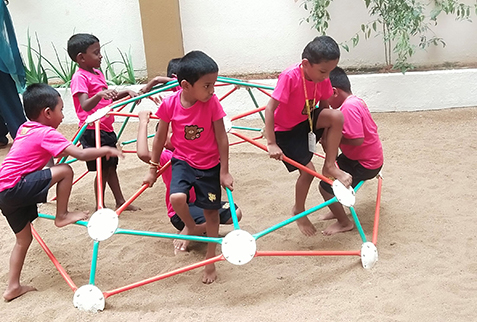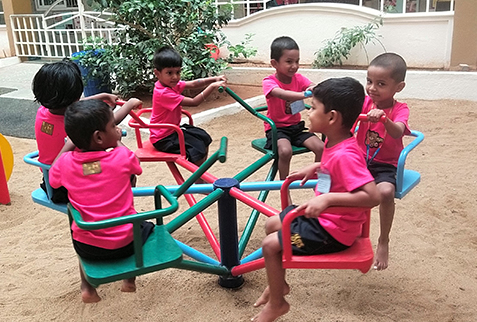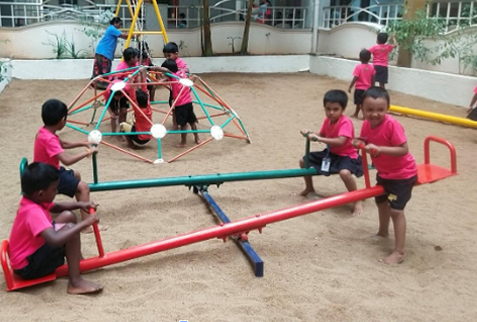Playground in school provides opportunities for young children to socialize with their peers and make new friends. These are the materials that are placed in our play area.

The balance beam enables children to be challenged while improving balance and coordination.
Children improve vestibular balance, movement coordination,body posture, limb muscle co-ordination, gross muscle movement and concentration while understanding their body's centre of gravity. The balance beam also helps to improve self-confidence, learning stability and sense of reaction.
Having the balance and coordination to successfully carry out gross motor skills reduces the likelihood of injury and thus increases the longevity of the child's ability to be involved in sporting pursuits.


This geometric metal climbing structure is not only a source of entertainment for children, but also enhances children’s physical strength and keeps them flexible and healthy.
Children like to climb mountains, do some gymnastics and play in structures. This also presents challenges for the children, because they want to be good at climbing up or down the dome quickly. In this, their muscles become stronger and their grip is enhanced, and they are busy trying various imaginative trainings on the dome climbers.
Studies show that playground merry-go-rounds contribute to the physical, motor, cognitive, and affective development of a child; therefore, can be an invaluable addition to children’s play spaces
Children enjoy the spinning motion and the challenge provided by a playground merry-go-round as they try to keep it spinning. Merry-go-round engages all body muscles to function and endure, achieve balance, coordination, and spatial awareness.
When boys and girls spin, different parts of their brain are simultaneously invigorated.
The emphasis of playground merry-go-rounds as part of a child’s movement experience, results from its effect on the physical domain of human development, more specifically the development of the vestibular system.


During rope play, children must focus and use a greater degree of self-control while climbing, instinctively reacting to each movement while they make decisions about which rope to grab next. They must do all of these things while also challenging their own motor skills.
There are many other benefits, some of them including:
Rope ladders can also improve children's stamina and overall health, and these benefits may have a positive impact on their health later in life. Hand-eye coordination can also be improved. This is because climbing requires high degree of focus and concentration, which are skills that benefit your child holistically in the future. Climbing is also a great way to help your child to overcome fears and gain self-esteem. Once your child masters the challenge from climbing, they will learn that it may be fun to face their fears and give it a go instead of avoiding it.
Seesaws are a classic part of every playground,offering the opportunity for children to practice balancing, communication, and cooperation with each other. They have a simple design that is easily integrated into any playground site but is still popular with the children.
One theory on the origin of the seesaw that appears in “The Oxford Book of Nursery Rhymes” involves children borrowing a plank and a log from the local sawyers to rock up and down on for play.


Slides are one of the most enjoyable playground equipment for children. Children love the thrill and fun they get through playground slides. Keeping safety measures and guidelines in mind and supervising children when they are playing around slides, we are ensuring your child to truly experience a thrilling rush of adrenaline without fear of any major injury.
Although the sliding activity is exciting and thrill-seeking for children, it also requires significant confidence to climb up at a height and slide down swiftly. It's an enormous confidence-booster for young children when they face the challenges of a tall slide, and win.
When a child scales a slide and afterwards effectively propels themselves down the slide panel, they are learning important balance and coordination skills. That activity further helps in enhancing spatial development, as they need to timely determine the opportunity to slide and when to put their feet down once they arrive at the base of the sliding panel.
Swings are the most powerful and most desired play equipment of children. Even adults love swings and enjoy their rides whenever possible. There are so many benefits of enjoying swings but a few are aware of it.
Children who are between 2 to 4 learn to push and pump while swinging. Doing this, helps them control their motor nerves and also coordination among their body parts.
There are various muscles and tendons located deep inside the joints and get triggered whenever there is a pull or push. When children try to push swings hard, that body tendon or the deep receptors wake up and stimulate the signals around the brain which activate children’ thinking and learning ability.
When children do swings rides, it helps raise endorphins that can wake up a sleepy brain and body. Also, these swings help in maintaining the blood flow in your brain and create a better environment for your children to be focused and attentive.
Last but not least is the special quality of swings that is the mood booster. Swings are an excellent source of a mood booster, no matter children or adults. Whenever you need to boost your mind, do nothing, just hop on to the swings and get yourself lost in the world of happiness.


Increased outdoor physical activity at school can also help reduce the childhood obesity epidemic and create healthy habits for exercise that will continue at home.
This play equipment enhances upper body strength while targeting skills such as grip strength, hand-eye coordination, and visual perception and also facilitate independent gross motor play.
It can also increase heart rate and improve cardiovascular health, agility, balance, and hand-eye coordination.
2023 senthil public school salem. all rights reserved. designed by aatmia.